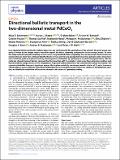Files in this item
Directional ballistic transport in the two-dimensional metal PdCoO2
Item metadata
| dc.contributor.author | Bachmann, Maja D. | |
| dc.contributor.author | Sharpe, Aaron L. | |
| dc.contributor.author | Baker, Graham | |
| dc.contributor.author | Barnard, Arthur W. | |
| dc.contributor.author | Putzke, Carsten | |
| dc.contributor.author | Scaffidi, Thomas | |
| dc.contributor.author | Nandi, Nabhanila | |
| dc.contributor.author | McGuinness, Philippa H. | |
| dc.contributor.author | Zhakina, Elina | |
| dc.contributor.author | Moravec, Michal | |
| dc.contributor.author | Khim, Seunghyun | |
| dc.contributor.author | König, Markus | |
| dc.contributor.author | Goldhaber-Gordon, David | |
| dc.contributor.author | Bonn, Douglas A. | |
| dc.contributor.author | Mackenzie, Andrew P. | |
| dc.contributor.author | Moll, Philip J.W. | |
| dc.date.accessioned | 2022-05-24T10:30:14Z | |
| dc.date.available | 2022-05-24T10:30:14Z | |
| dc.date.issued | 2022-05-09 | |
| dc.identifier | 279712767 | |
| dc.identifier | 079d91fe-6fda-43fd-8612-153476af0576 | |
| dc.identifier | 85129697712 | |
| dc.identifier | 000792553700001 | |
| dc.identifier.citation | Bachmann , M D , Sharpe , A L , Baker , G , Barnard , A W , Putzke , C , Scaffidi , T , Nandi , N , McGuinness , P H , Zhakina , E , Moravec , M , Khim , S , König , M , Goldhaber-Gordon , D , Bonn , D A , Mackenzie , A P & Moll , P J W 2022 , ' Directional ballistic transport in the two-dimensional metal PdCoO 2 ' , Nature Physics , vol. 18 , pp. 819-824 . https://doi.org/10.1038/s41567-022-01570-7 | en |
| dc.identifier.issn | 1745-2473 | |
| dc.identifier.other | RIS: urn:359B516E78EF87F0DC72BC2767B1B609 | |
| dc.identifier.uri | https://hdl.handle.net/10023/25439 | |
| dc.description | Funding: This project was supported by the Max Planck Society and the European Research Council (ERC) under the European Union’s Horizon 2020 research and innovation programme (MiTopMat, grant agreement no. 715730). M.D.B. and P.H.M. acknowledge EPSRC for PhD studentship support through grant number EP/L015110/1. Research in Dresden benefits from the environment of the Excellence Cluster ct.qmat. A.S. acknowledges support from an ARCS Foundation Fellowship, a Ford Foundation Predoctoral Fellowship and a National Science Foundation Graduate Research Fellowship. Computational work was performed on the Sherlock cluster at Stanford University and on resources of the National Energy Research Scientific Computing Center, supported by the DOE under contract DE_AC02-05CH11231. T.S. acknowledges support from the Emergent Phenomena in Quantum Systems initiative of the Gordon and Betty Moore Foundation, and from the Natural Sciences and Engineering Research Council of Canada (NSERC), in particular the Discovery Grant (RGPIN-2020-05842), Accelerator Supplement (RGPAS-2020-00060) and Discovery Launch Supplement (DGECR-2020-00222). T.S. contributed to this work prior to joining AWS. D.G.-G.’s and A.W.B.’s involvement in calculations was supported by the US Department of Energy, Office of Science, Basic Energy Sciences, Materials Sciences and Engineering Division under contract DE-AC02-76SF00515. E.Z. and M.M. thank the International Max Planck Research School for Chemistry and Physics of Quantum Materials (IMPRS-CPQM) for financial support. G.B. and D.A.B. acknowledge support from the Natural Sciences and Engineering Research Council of Canada (NSERC Discovery Grant RGPIN-2018-04280) and from the Canada First Research Excellence Fund. Open access funding provided by Max Planck Society. | en |
| dc.description.abstract | In an idealized infinite crystal, the material properties are constrained by the symmetries of the unit cell. The point-group symmetry is broken by the sample shape of any finite crystal, but this is commonly unobservable in macroscopic metals. To sense the shape-induced symmetry lowering in such metals, long-lived bulk states originating from an anisotropic Fermi surface are needed. Here we show how a strongly facetted Fermi surface and the long quasiparticle mean free path present in microstructures of PdCoO2 yield an in-plane resistivity anisotropy that is forbidden by symmetry on an infinite hexagonal lattice. We fabricate bar-shaped transport devices narrower than the mean free path from single crystals using focused ion beam milling, such that the ballistic charge carriers at low temperatures frequently collide with both of the side walls that define the channel. Two symmetry-forbidden transport signatures appear: the in-plane resistivity anisotropy exceeds a factor of 2, and a transverse voltage appears in zero magnetic field. Using ballistic Monte Carlo simulations and a numerical solution of the Boltzmann equation, we identify the orientation of the narrow channel as the source of symmetry breaking. | |
| dc.format.extent | 7 | |
| dc.format.extent | 1868380 | |
| dc.language.iso | eng | |
| dc.relation.ispartof | Nature Physics | en |
| dc.subject | QC Physics | en |
| dc.subject | TK Electrical engineering. Electronics Nuclear engineering | en |
| dc.subject | DAS | en |
| dc.subject | MCC | en |
| dc.subject.lcc | QC | en |
| dc.subject.lcc | TK | en |
| dc.title | Directional ballistic transport in the two-dimensional metal PdCoO2 | en |
| dc.type | Journal article | en |
| dc.contributor.sponsor | EPSRC | en |
| dc.contributor.institution | University of St Andrews. School of Physics and Astronomy | en |
| dc.contributor.institution | University of St Andrews. Condensed Matter Physics | en |
| dc.identifier.doi | https://doi.org/10.1038/s41567-022-01570-7 | |
| dc.description.status | Peer reviewed | en |
| dc.identifier.grantnumber | EP/L015110/1 | en |
This item appears in the following Collection(s)
Items in the St Andrews Research Repository are protected by copyright, with all rights reserved, unless otherwise indicated.

